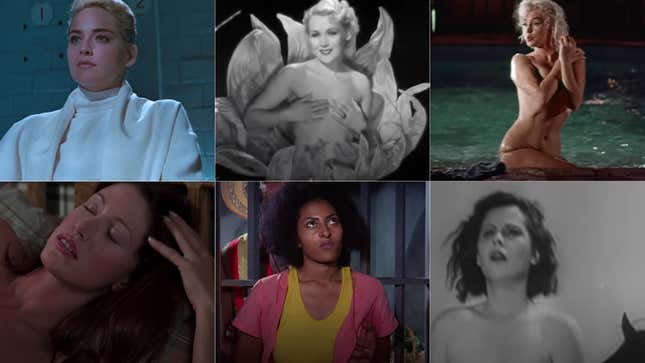
Screenshot: Array
Even in a time when galaxies of explicit sexualities are mere keystrokes away, there is something about nudity in mainstream, non-pornographic entertainment that continues to enthrall. Maybe it is the thrill of transgression, the flash of the bare in an otherwise clothed context. Maybe it’s a sort of wish fulfillment in seeing the mortal flesh of superstars who hold godlike positions in Western culture. Maybe it’s this simple: Scarcity has a tendency to leave people wanting more, and in the absence of increased commodity, there is discourse. And discourse upon discourse. Director Danny Wolf makes use of dozens of talking-heads to discuss dozens of unclothed cinematic landmarks in his new documentary Skin: A History of Nudity in the Movies, which is now available through video on demand.
The doc features stars who have dropped trou (Malcolm McDowell and Sean Young among them), directors whose films have featured nudity (like Fast Times at Ridgemont High’s Amy Heckerling and The Last Picture Show’s Peter Bogdanovich), intimacy coordinator Alicia Rodis, and journalist/critics like The Hollywood Reporter’s Tatiana Siegel and Variety’s Amy Nicholson. The MPAA’s now-retired ratings chief Joan Graves shows up to recite the association’s oft-repeated speaking point: They are not a board of censors. Of course, the group’s ratings can effectively censor a film whose targeted rating it falls short of (thus requiring cuts in order to meet it), but this, like a lot of things in the doc, goes uncontested. In shuffling through so much information and film history, Skin has only so much time to do so much, even within its rather hearty two-hour-plus duration. (There is, however, during the credits sequence, a great anecdote from Gremlins director Joe Dante, who says he and collaborator/B-movie god Roger Corman would submit their movie to the MPAA, make the suggested cuts, and then reinsert them before the films were distributed to theaters since the MPAA didn’t follow up once it had assigned its final rating.)
Skin is not quite the embarrassment of riches that a more streamlined and A-list populated movie on the subject might have been, but it is a well of fun facts and trivia that’s captivating throughout. Fun fact: The Catholic Church had a rather visible hand in early movie censorship endeavors. Fun fact: 1934’s Tarzan and His Mate marked the first use of a body double during a nude swimming scene. Fun fact: An American cut of 1969’s Women in Love excised much of the movie’s notorious naked-wrestling match between Oliver Reed and Alan Bates so that viewers saw its inception and then the pair lying panting on the floor as if to imply sex had taken place between the men. Denying the full context made the film open to an interpretation that was much more explicit than its original form.
-

-

-

-

-

-

-

-

-

-

-

-

-

-

-

-

-

-

-

-

-

-

-

-

-

-

-

-

-

-

-

-

-

-

-

-

-

-

-

-








































